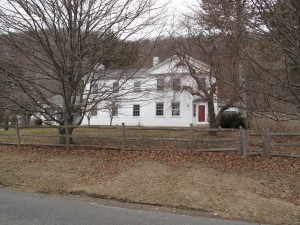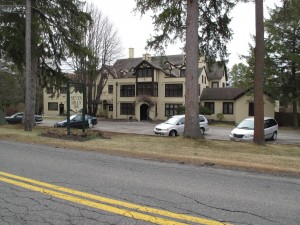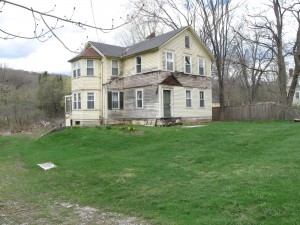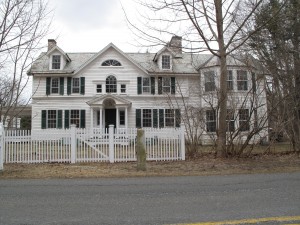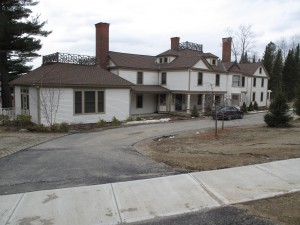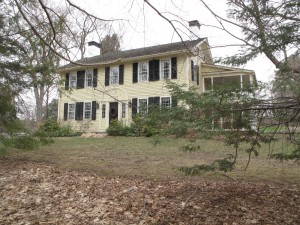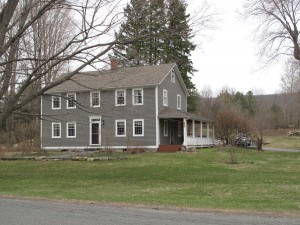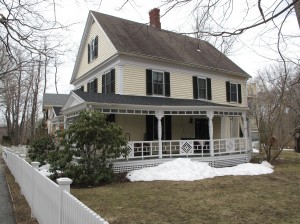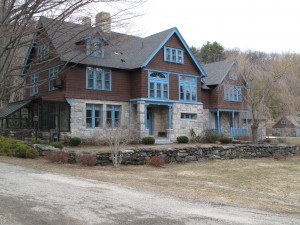
From Surveys Completed 2011-2012 by the Lenox Historical Commission
ARCHITECTURAL DESCRIPTION:
The property contains a complex of farm buildings, almost all of which exhibit the architectural characteristics of the Arts and Crafts style. The farmhouse is two stories in height, has a 5-bay front façade, and is two bays deep. It has both stone and wood frame construction. Random rough-face cut stones quarried on the site clad the first floors, while wood shingle siding is used on the upper portions of the house. It has a gable roof with gable dormers; verge boards have decorative scroll sawn ends. There are two large stone interior chimneys. There are two front gabled pavilions, each with a porch. The one on the right side of the front façade is under a second floor overhang, which is supported by turned posts, and has a millwork railing. A group of four double hung sash windows are on the second floor above it and a pair of attic windows above them. The porch on the left side is also under a second floor overhang—on the left side only. Two simple turned posts atop stone piers plus a massive stone pillar support the overhang. On the second floor are two sets of three windows, each set having a large fanlight transom and at the attic level is a set of three windows with four small brackets below; the shingle siding above flares out over them. Virtually all the windows are 1-o-1 double hung sashes, which may be original or replacements. There is a 2-story right side ell with slightly lower gable roof from which a 1-story hipped roof extension projects. A glazed conservatory has been added to the left side of the house, which has a shed roof that is partly solid and partly glazed.
A 2-plus-story basement barn is located to the right of the house. It has a gable roof and an exposed stone basement on the front and is clad with wood shingles above. A cross-gabled second floor pavilion is supported with scroll sawn brackets that contained the original hay door (now infilled with windows). Four- and 6-light barn sashes are set into the stone wall on the front. The entrance door is paneled. Double swing doors on the left side have 6-light windows over vertical panels. Lozenge windows are in the gable peaks. A roof vent has a hipped roof. A stone endwall chimney is on the left side. Extending from the left side of the barn is a recessed 1-story ell with gable roof and two cupola vents. It has a hay door in a dormer. A garage wing extends of its left side containing two double vehicle bays with newer overhead doors. That section has a large wood shingled front gabled dormer.
A long 1-story outbuilding with gable roof, set well back from the house and barn has a stone kneewall with wood shingle cladding above. Its front façade is articulated with a shallow, hipped-roof pavilion three bays wide, a projecting gable, and a smaller gabled bump-out. There are eight bays with paired windows plus a 2story polygonal turret at the far right side. A stone chimney is located between the gabled section and turret. A millwork railing encloses a patio area in front of the turret
A third outbuilding has been attached to the rear of the farmhouse with a 1-story hyphen. Another small, 1-story outbuilding, located between the house and barn, is a one-room schoolhouse that was moved to the property. It has a hipped roof topped with a bellcote. There are three glass doors on the front and four double hung windows on its left side. A stream runs from the hills behind the buildings between the various buildings and has been damned to create a small, stone-lined duck pond in the front yard (with attendant tiny duck house beside it). There is a stone wall in front of the house and a long one that runs along and across the road from the property. Mature specimen, deciduous and coniferous trees are scatted throughout the site, which also has open lawn areas.
Architect Charles T. Rathbun -1908[1]
Rathbun served as a Commissioner for Pittsfield’s “Main-drains, common sewers, and sidewalks” from 1867 – 1875.[2]
Other Buildings Designed by Rathbun (from MACRIS, unless otherwise footnoted):
1870 – Citizens’ Hall, West Stockbridge
1872 – Methodist Episcopal Church, Pittsfield[3]
1873 – Old Gas Works, Pittsfield
1874 – Memorial Town Hall, Lee
1874 – First Baptist Church (remodeled), Pittsfield[4]
1880 – Oman Block, Lee
1881 – Central Block, Pittsfield
1884 – Rosa England Block, Pittsfield
1887 – Hoosac Street School, Adams
1890 – Second Burns Block, Pittsfield
1893 – Housatonic Congregational Church, Great Barrington
HISTORICAL NARRATIVE:
Stonover Farm was built in 1870 by John Parsons as the farm house for the Parsons Estate, Stonover on Yokun Avenue. The house was maintained by Mr. Herbert Parsons, a New York Congressman and his wife Elsie Crews (who was one of the first female anthropologists, AH). They lived there with their daughter who maintained the property after their death, Mrs. John D. Kennedy. Mrs. Kennedy left the property to Mr. Herbert Patterson of New York. After his death he left the property to his secretary. The property was then purchased by Mr. and Mrs. Jonas Dovydenas.
The property without the barn was transferred to Lawrence and Rosemary Geller in 1990. Tom and Suky Werman purchased the house in 2000 and the barn in 2003 and have made extensive renovations to convert Stonover Farm into a renowned Bed and Breakfast Inn.
BIBLIOGRAPHY and/or REFERENCES:
Marcia B. Brown
Janet H. Pumphrey
Town of Lenox Assessor Card
[1] American Architecture & Building News, VOL. XCIV, No. 1703, August 12, 1908 issue, p. 16.
[2] J. E. A. Smith, History of Pittsfield From the Year 1800 to the Year 1876, (Springfield, MA: C. W. Bryan & Co, 1876), p. 572.
[3] Ibid, p. 446.
[4] Ibid, pp.442-443.

